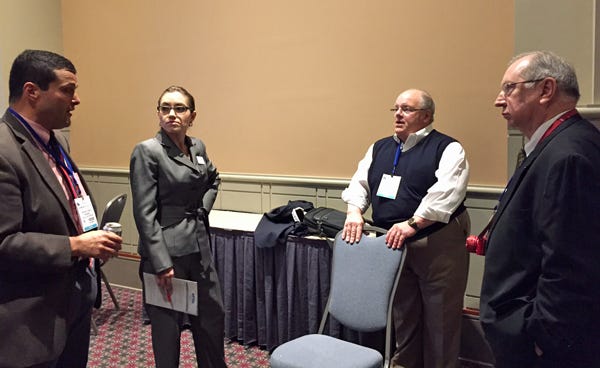Biocompatibility Is Dead, Long Live Biocompatibility
October 9, 2015
According to Mike Drues, mere biocompatibility is just a description for a material that can be implanted in your body without killing you. Len Czuba begs to differ, finding that the standard he has worked his whole life to uphold is not a notion that will go out of style.
Chris Newmarker
|
Vascular Sciences president Michael Drues, far left, and Czuba Enterprises principal Len Czuba, far right, continue their discussion of biocompatibility testing after the official "debate" at MD&M Philadelphia on Thursday. UBM Canon live content manager Kristina Stiens, second from left, and Secant Medical R&D vice president Peter Gabriele, second from right, listen in. (Photo by Chris Newmarker) |
Is the medical device industry too conservative when it comes to its choice of materials? Or is it foolhardy from a regulatory and safety standpoint to move away from using tried-and-true materials and biocompatibility testing?
Two medical device testing and regulatory experts--Vascular Sciences president Mike Drues and Czuba Enterprises principal Len Czuba--wrestled with these questions during a spirited debate Thursday, October 8, at MD&M Philadelphia.
"The vast majority of the materials we use in medical devices were never designed to go in the human body. And that's a huge problem," said Drues, who is president of Vascular Sciences (Grafton, MA). Drues played a TED talk from MIT professor Robert Langer, who pointed out that device developers in past decades simply looked around the house when looking for materials to use in medical devices. When looking for a material for artificial heart, an enterprising cardiosurgeon found the answer in the from the polyether used in a ladies girdle. Similarly, cellulose acetate in sausage casing proved to be suitable for dialysis tubing.
Extensive testing over the decades has demonstrated that such materials are compatible with the human body. The standards organization ISO developed the ISO 10993 to codify what biocompatibility means for both the device industry and for international regulatory bodies.
But Drues thinks that mere biocompatibility is a rather limited benchmark for material selection. To put it politely, he thinks that most of the biocompatible materials out there are "not very good" because they are inert instead of "biofriendly."
"Biocompatible simply means, 'We put something into the body, and the patient does not drop dead.' It does not mean the body likes the material. It means the body tolerates the materials," Drues said.
"I think what you're saying is, 'Throw all that testing out,'" replied Czuba, who is principal of Czuba Enterprises (Lombard, IL). Czuba pointed out that decades of trial and error and evolving ideas created the detailed procedures used to test--in exact order--the physical/functional, chemical, and biological compatibility of medical device materials evolved.
"Are we throwing out the baby with the bathwater?" Czuba said, referring to Drues' recommendation to move beyond the biocompatibility standard.
Perhaps there is a paradigm shift going on, the panel moderator Peter Gabriele, vice president of R&D at Secant Medical (Telford, PA), said at the start of the debate. "I don't know if we're going to shift the paradigm today," Gabriele said. Still, he acknowledged there is a real need to get medical device materials to help the body to heal itself, versus simply not harming it. Secant itself has acquired some of Langer's biofriendly materials technology.
By a show of hands, most of the roughly 50 medical device experts in the room revealed that they found device materials to be merely "OK," and few had studied molecular biology and cell biology.
Drues urged the audience to look to the human body for inspiration, looking to identify materials already within the body for use in implantable medical devices that are "biofriendly." "I think we should be studying immunology. We want to understand how the body is designed to work. Can you name for me one material in your body that is not chemically active in some way?" Drues said.
"FDA friendly is just codespeak for using a material that's already been used before. It's the path of least resistance. It's the 'least' approach," Drues said.
Drues mused that lengthy testing may not be needed for a material that is substantially equivalent to a protein already inside the human body.
"In the world of Michael Drues, that's great. But in the real world where most of us live, we're living with the FDA and have to comply with the test that they say need to be done," Czuba said.
Czuba noted that the PVC used in medical devices was once heavy metal-stabilized, which turned out to be dangerous. "We would not have known we needed to remove it if we hadn't done these basic tests."
Drues acknowledged that biocompatibility testing is fine for many medical devices. But for the small portion of devices that are implantable, he wants something better.
"If we were design a brand new material at the individual atoms and molecules on up--for use in the body--what would it look like?"
Chris Newmarker is senior editor of Qmed and MPMN. Follow him on Twitter at @newmarker.
Like what you're reading? Subscribe to our daily e-newsletter.
About the Author(s)
You May Also Like



